On the 12th February 1945, one year and five days after their previous attempt to establish a base, members of Operation Tabarin returned to Hope Bay aboard the SS Eagle.
This was a location well-known to them. Forty-three years earlier, six members of the ill-fated Swedish South Polar Expedition (1901-03) led by Otto Nordenskjold had endured two winters on Snow Hill Island, to the south of Hope Bay, when their ship had failed to return and collect them. And at Hope Bay itself, three further members of the expedition, tasked with sledging to Snow Hill Island to bring Nordenskjold back to Hope Bay for collection, had also been forced to over-winter in a rough stone hut that they constructed. Marr had taken a copy of Nordenskjold’s account of the expedition with him, and members of Tabarin would have known his story – of the ship lost to the ice, the harsh conditions endured, and the eventual rescue by the Argentine gunboat Uruguay.
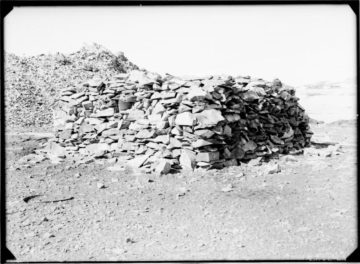
The Snow Hill Island site would be explored by them later in the year. But on landing and selecting a site for the new base hut, the stone hut at Hope Bay was investigated immediately. This task fell to Lamb.
Meanwhile, the remaining members of the party investigated an appropriate site for the new base:
“… The others of us met at the appointed place at 1530 LST, and discussed our findings. Matheson and I had found a good site except that the landing beach was very shallow at low tide. Ashton and Flett had one rather higher up, with also a poor landing approach and no water supply: also it was surrounded by penguins. Berry and Russell had another to the south of Hope Bay in a large cove. We looked at the first two of these in turn, but they were not very happy choices. In passing the last of these three sites, which appeared to be a wet one, we found another which no one had yet examined, at the foot of the glacier south of Hope Bay. Two level extents of rock, each roughly 100ft square, were divided by a shallow gulley, through which coursed a swiftly moving stream of pure glacial water. They were clear of the penguins; near the glacier for summer and winter water supply; near the glacier for training the dogs: and fairly good approaches from the sea to a narrow shallow ice foot. We decided upon this site, and though it is completely exposed to east and northeast winds, and consequently subject to heavy swells, it seemed to have no other disadvantages.”
Source: Andrew Taylor base diary. (Archives ref: AD6/1D/1945/B)
Film: The stone hut at Hope Bay being investigated by Lamb, William Flett and Captain Robert Sheppard of the Eagle, Feb. 1945. (Archives ref: AD6/16/1946/1.1)
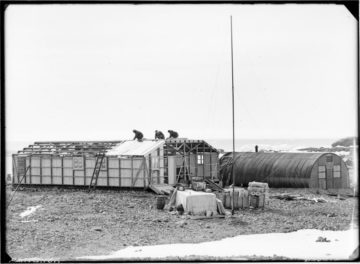
“The construction of the new base started the next day, initially on a small temporary tin galley:
…[T]he first scowload of stores went ashore at 1600 hours on February 13th, and Ashton immediately set to work on the construction of Berry’s temporary galley which he had prepared at Port Lockroy. We chose a site for it as near the sea as possible…and along the west side of a little stream, which was running well to provide a temporary water supply. The frames of walls were fitted together, the roof frame added, and all was covered with sheets of corrugated iron brought from Deception Island. By the next evening, a floor had been laid and Berry had set up his cookhouse with the very limited culinary utensils which he had brought from Port Lockroy also. That night five men slept ashore in the building, and within the next day or so, all were ashore except Farrington and Russell, the latter remaining aboard the ship to control the flow of stores to provide as much as possible with our requirements as they became necessary.
In order to alleviate the accommodation problem, Matheson erected a tent across the other side of the stream, and Davies and Marshall moved in there with him. Later on, when Farrington came ashore, he erected one of the little Arctic pyramid tents in which he set up a walkie-talkie radio; he and Back slept there a few nights, but all the others of us had bunks in the little tin hut.”
Source: Andrew Taylor expedition report. (Archives ref: AD6/1D/1945/A)

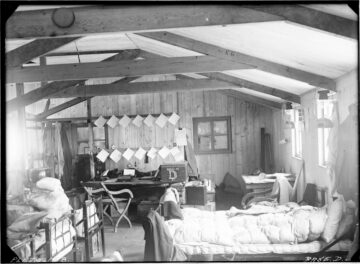
The construction of the base proper, Eagle House named after the ship that had delivered them to Hope Bay, was started a few days later. In placing two structures side by side, a large building, 32 feet by 38 feet, was constructed. Taylor describes the design and layout:
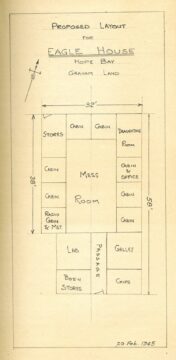
“Tuesday, 20th February 1945
I drew up a proposed layout for the house, showing the interior partitions, the uses of each room, including the inhabitants of each cabin. Every man saw it, and was free to make individual suggestions. With one or two minor alterations, it was generally approved by everyone… The governing principle involved in the layout has been to avoid any necessity for aisles or corridors, so giving us the maximum use of available space. It will mean the removal of central walls of the pair of houses and the insertion of a beam and supporting columns, but Chippie assures me that he can manage this. The main or mess room may then be centrally located with cabins and individual workrooms around the perimeter, the light from which will collectively illuminate the mess room; we used this system, in a measure, at Port Lockroy last year, and it was found to give ample light except in the depth of winter. Each cabin will be eight feet square, instead of the six feet we had last year at Base A. Lamb’s darkroom lies near the galley stove, from which it will derive some heat. The galley is adjacent to the messroom for convenience in serving. The sanitary facilities will be as far as possible from the galley, and will be contiguous to a drainage run independent of our water supply. A small storage space will be available in the store room, but all personal gear, clothing stocks etc., will have to be accommodated in the cabins or Nissen hut, while food stocks will be kept in the galley.”
Source: Andrew Taylor base diary. (Archives ref: AD6/1D/1945/B)
This extended film shows progress on the construction of the station buildings, which were finally completed towards the end of April 1945.
Film: The construction of Eagle House, Feb-Apr 1945. (Archives ref: AD6/16/1946/1.1)
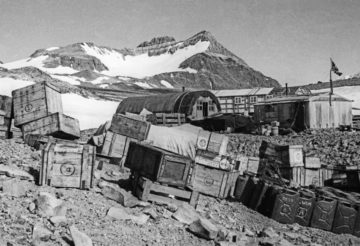
During this time, the Eagle had continued to ferry supplies between Deception, Hope Bay and Port Lockroy. But on the 17th March, the crew and Tabarin personnel were reminded of how precarious Antarctic operations could be, and, as with Nordenskjold’s expedition, how dependent upon the ships the Operation was, as Eric Back recalls:
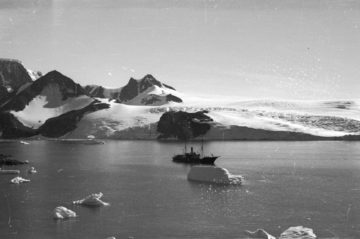
George James, wireless operator on the HMS William Scoresby, also remembers the incident:
Despite this setback and loss of stores, the scientific and survey work continued at Hope Bay.